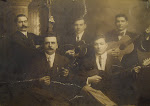 |
| Stevan Bačić-Trnda |
Born in the village of Stapar in 1870, he grew up in nearby Sombor and studied violin from an early age with some of the city's most prominent musicians. Trnda went on to play in the tamburica orchestras of some of the greatest legends of his day, gaining vast knowledge and experience along the way. Eventually gathering together a group of his own, Trnda and his orchestra started out playing regular gigs at the best establishments in Sombor. A violin virtuoso, his unique style often pushed the boundaries of traditional folk music and set him apart from other musicians of his day. He was a powerful tenor, and his vocal style fit so perfectly with his playing that it was often hard to tell where one began and the other ended. As a band leader, Trnda's interpretations of the old songs were powerful, full of emotion, and whether elaborate or simple, they were always uniquely his own. In the first decade of the 20th century, Stevan Bačić-Trnda and his band were in real demand and played engagements all over Vojvodina, even touring Bosnia, in the process spreading the music that was popular back home. He also brought back many beautiful old Bosnian songs and melodies, sevdalinke, and even Serbian folk songs that were popular in Bosnia but hadn't been heard back home for generations. In the years before the First World War, Trnda and his orchestra traveled Europe and made an unknown number of recordings for the Gramophone Co., Beka, and others. Trnda was even invited to Chicago in 1928 along with a group of musicians from his
 hometown of Sombor, including tambura legend Šanjika Grebenar. In 1930, Trnda traveled back to Vienna, Austria, to make what would be his last recordings. He was accompanied by another famous Sombor musician, gajdaš (bagpiper) Kosta Šarčanski-Koca. Between the 18th and 19th of September Stevan Bačić-Trnda, and his now smaller six piece tamburica orchestra, laid down 26 tracks of an amazingly wide variety, from old folk songs, to Bosnian sevdalinke, to starogradske pesme (old city songs). He also recorded a number of songs by contemporary composers like Marko Nešić, Mita Gruijć, and Stanislav Binićki. Trnda died just five years later, in 1935, in his hometown of Sombor.
hometown of Sombor, including tambura legend Šanjika Grebenar. In 1930, Trnda traveled back to Vienna, Austria, to make what would be his last recordings. He was accompanied by another famous Sombor musician, gajdaš (bagpiper) Kosta Šarčanski-Koca. Between the 18th and 19th of September Stevan Bačić-Trnda, and his now smaller six piece tamburica orchestra, laid down 26 tracks of an amazingly wide variety, from old folk songs, to Bosnian sevdalinke, to starogradske pesme (old city songs). He also recorded a number of songs by contemporary composers like Marko Nešić, Mita Gruijć, and Stanislav Binićki. Trnda died just five years later, in 1935, in his hometown of Sombor.Unfortunately, like so many Serbian artists who recorded before WWII, Stevan Bačić-Trnda's records are now few and far between. I was fortunate that my great-grandfather kept some of his records and was careful to preserve them. I've been able to find others along the way as well. The records I've posted below are some of my favorites. The orchestra sounds smaller than was usual for Trnda during this time period before WWI. The arrangements aren't as complicated and there's an intimate feel to them, somewhat more improvisational than some of his other early recordings. I think these four tracks are good examples of his unique and personal take on the old folk songs. Unfortunately I have yet to find anything from his 1930 Vienna sessions.
Thank you to my good friend Petar Stojkov who was so kind and helpful in providing me with historical information about Stevan Bačić-Trnda. He grew up in Sombor too, just down the street from the famous kafana "Ratar" where Trnda's orchestra entertained regularly at the turn of the century. Petar's great-grandmother even worked there as a chef in those days. Unfortunately, the "Ratar" was demolished some 50 years ago.
Tuga me mori
Gine vene srce u menika































.jpg)






Thank you for this wonderful blog, and for your youtube channel. I love the music you have shared, it's beautiful. Do you have mp3s perchance? I'd love to listen to this frequently.
ReplyDeleteHi, thanks so much for commenting. I'm really happy you like the music. And yes, these are all downloadable as mp3s. Just "right click" on the pictures of the record labels and select "Save File As" (or "Save Link As" if you use Firefox). Then you can choose where you want to put it on your computer and click "Save". Let me know if you have trouble saving the mp3s.
ReplyDeleteThanks again,
Steven Kozobarich
skozobar@gmail.com
One more thing. It has just been brought to my attention that most of the music links are down for the moment. It's probably just temporary, but if not I'll upload them to a new server.
ReplyDeleteThanks,
Steven
Хвала, хвала.
ReplyDeleteIt´s much easier to download from this new server then the one you have used before. Thank you Mister Kozobarich. Greetings from Novi Sad.
Thank you so much for this blog, which is an historical document in itself. I had never heard of Tamburitza music before. I have spent the last three days downloading and reading your entire catalog and am absolutely loving it. Thank you so much for this creation and for keeping this music alive to teach folks like myself something new.
ReplyDeletewww.driftinghighplains.blogspot.com
Thanks so much for writing. It's always great to know when someone appreciates the site so much. I hope you found some music that you enjoy here. I'm working on adding more records now, so it shouldn't be long before I start making new posts again. And I have a YouTube site too:
Delete(http://www.youtube.com/user/kozobar).
Thanks again!
Steven